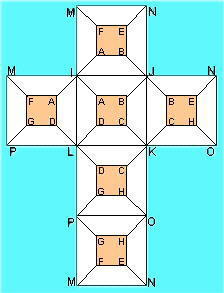The network represents a map of the edges and vertices of a
hypercube or more precisely, a tesseract when imposed within 2D space.
 |
The orange squares represent the faces of the internal cell, a cube in 3D space, and is defined by vertices A to H. The larger bolder letters, I to P are the vertices of the outer cell/cube.
The diagonal lines are the edges which link the inner to the outer forming the faces that configure the cells which interface to the inner and outer cells.
Let each hypercell have a value which is the vertex sum of each of its enclosing faces (or three times the sum of its 8 vertices).
|
The vertices are to be numbered uniquely from 1 to 16, and for consistency of reference, let
A always be 1.
Find sets of values for A through P so that all the cells have the same value.
Note: while the on-line calculator may be useful, a spreadsheet should prove more valuable for those able to use one.
(In reply to
re: computer solution by Charlie)
Using A=1 and B < D < I < F, I get 155,775 solutions. Multiplied by 24 it comes to 3,738,600, in agreement with Daniel's count.
C and D are definitely reversed on the diagram from what's implied by the calculator portion.
BTW, the only changes to the program were interchanging C and D in the for...next loops and the setting and clearing of the used() array members, and in the addition that goes into variable ae.
Edited on February 3, 2009, 12:39 pm
Edited on February 3, 2009, 1:41 pm
|
|
Posted by Charlie
on 2009-02-03 12:36:50 |




